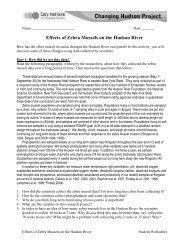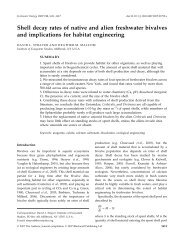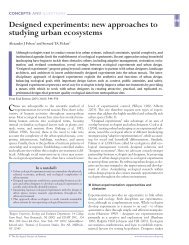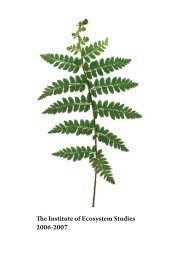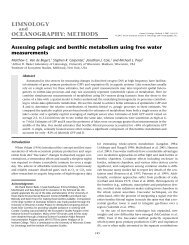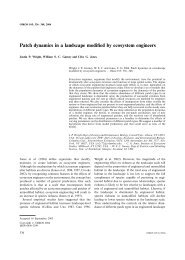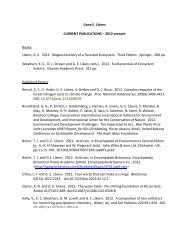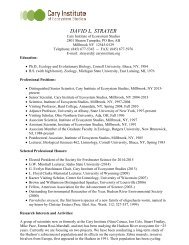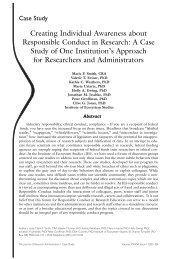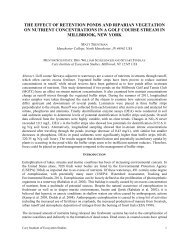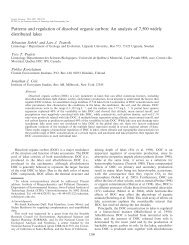2011 Annual Report (pdf, 2 MB) - Cary Institute of Ecosystem Studies
2011 Annual Report (pdf, 2 MB) - Cary Institute of Ecosystem Studies
2011 Annual Report (pdf, 2 MB) - Cary Institute of Ecosystem Studies
Create successful ePaper yourself
Turn your PDF publications into a flip-book with our unique Google optimized e-Paper software.
The science behind environmental solutions<br />
<strong>Annual</strong> <strong>Report</strong> <strong>2011</strong>
Table <strong>of</strong> Contents:<br />
Letter from the President......................................................................1<br />
Letter from the Chairman <strong>of</strong> the Board.............................................2<br />
Institutional Pr<strong>of</strong>ile................................................................................3<br />
Research Highlights..........................................................................4-13<br />
Selected Books and Papers................................................................. 14<br />
Major Scientific Staff Distinctions................................................... 15<br />
Scientific Seminars.............................................................................. 16<br />
Education.........................................................................................17-18<br />
Public Outreach................................................................................... 19<br />
Trails and Grounds.............................................................................. 20<br />
Fiscal Year <strong>2011</strong> Operating Results.................................................. 21<br />
Board <strong>of</strong> Trustees..........................................................................22-23<br />
Staff ..................................................................................................24-27
Letter from the President<br />
Every year I am overwhelmed by the breadth, depth,<br />
and impact <strong>of</strong> the scientific research conducted at<br />
the <strong>Cary</strong> <strong>Institute</strong>. This year is no exception. From<br />
Charles Canham’s analysis <strong>of</strong> the potential for northeastern<br />
forests to supply wood for energy and the impacts associated<br />
with such harvest, to Richard Ostfeld’s continuing work on<br />
the ecology <strong>of</strong> Lyme disease and how we might reduce our<br />
risk in regional forests, <strong>Cary</strong> scientists are addressing the<br />
environmental issues that matter.<br />
We continue to provide wise counsel on the ecological<br />
consequences <strong>of</strong> mountaintop-removal mining and the need<br />
for adequate regulation <strong>of</strong> hydraulic-fracture extraction <strong>of</strong><br />
natural gas from the Marcellus shale. Meanwhile, Stuart<br />
Findlay and Victoria Kelly have helped local communities<br />
to reduce their use <strong>of</strong> road salt to save money and minimize<br />
environmental impacts.<br />
This year also saw an expansion <strong>of</strong> the <strong>Cary</strong> <strong>Institute</strong>’s<br />
public programming. We are rapidly becoming the “hot<br />
ticket” for Friday night in Millbrook, with speakers such<br />
as environmentalist and 350.org founder Bill McKibben,<br />
Climate Central scientist Heidi Cullen, author Simon<br />
Winchester, Natural Resources Defense Council President<br />
Frances Beinecke, and our own scientists Emma Rosi-<br />
Marshall and Peter Gr<strong>of</strong>fman. With every presentation,<br />
we seek to translate the best, current science on important<br />
environmental issues to the public.<br />
This emphasis on communicating cutting-edge science also<br />
drives our K-12 education programs for local schools. The<br />
popularity <strong>of</strong> those programs, as well as the Ecology Camp<br />
held on our grounds, attests to meeting a public need. And,<br />
<strong>of</strong> course, we also advise and mentor a large number <strong>of</strong><br />
undergraduate, graduate, and postdoctoral students. This<br />
year we also <strong>of</strong>fered several classes in our cooperative<br />
program <strong>of</strong> teaching at Bard College.<br />
With Steward Pickett serving as President <strong>of</strong> the Ecological<br />
Society <strong>of</strong> America, Kathleen Weathers working as a<br />
Program Director at the National Science Foundation,<br />
and Jonathan Cole’s election as a Fellow <strong>of</strong> the American<br />
Geophysical Union, the <strong>Cary</strong> <strong>Institute</strong> continues to see its<br />
scientific staff represented at the highest levels <strong>of</strong> major<br />
scientific societies. Many <strong>of</strong> our scientists are asked to give<br />
significant time to boards and advisory committees for a<br />
wide variety <strong>of</strong> institutions.<br />
The <strong>Cary</strong> <strong>Institute</strong> depends upon donations from generous<br />
people who care about the environment and who hope<br />
that the best scientific knowledge underlies environmental<br />
regulations and policy. We provide that science.<br />
Read about us within these pages; you’ll like what you see!<br />
Then, if you are not already a member, consider joining<br />
the Aldo Leopold Society, a group <strong>of</strong> our most committed<br />
donors.<br />
William H. Schlesinger<br />
President<br />
Stay abreast <strong>of</strong> <strong>Cary</strong> <strong>Institute</strong> happenings, from events to breaking<br />
science, by signing up for our e-newsletter (www.caryinstitute.org) or<br />
following us on Facebook and Twitter.<br />
<strong>Cary</strong> <strong>Institute</strong> <strong>of</strong> <strong>Ecosystem</strong> <strong>Studies</strong> <strong>Annual</strong> <strong>Report</strong> <strong>2011</strong> 1
Letter from the Chairman <strong>of</strong> the Board<br />
The <strong>Cary</strong> <strong>Institute</strong> has earned its reputation as a<br />
world-class environmental research organization<br />
based on the strengths <strong>of</strong> its science. For nearly<br />
thirty years, its staff has been at the forefront <strong>of</strong> research<br />
into freshwater, air pollution, forest health, and disease<br />
ecology. The <strong>Cary</strong> <strong>Institute</strong> also plays a major role in<br />
training the next generation <strong>of</strong> ecologists, through handson<br />
field opportunities and graduate study.<br />
Under Bill Schlesinger’s leadership, the <strong>Cary</strong> <strong>Institute</strong><br />
has strengthened its commitment to translating science<br />
to citizens and policymakers. Since Bill’s arrival in<br />
2007, the organization has expanded its portfolio <strong>of</strong><br />
public <strong>of</strong>ferings, becoming a community resource for<br />
environment-themed lectures, weekend education<br />
programs, and management workshops on regionallyrelevant<br />
topics, such as freshwater and land use. It<br />
has also teamed with media outlets, most notably the<br />
Poughkeepsie Journal, to convey environmental science to<br />
citizens at large.<br />
As I read about the past year’s endeavors at the <strong>Cary</strong> <strong>Institute</strong>,<br />
I am struck by not only the achievements realized by the<br />
members <strong>of</strong> this organization but also the questions they<br />
pursue. From protecting freshwater to promoting the study <strong>of</strong><br />
cities as ecosystems, the research here is rich with innovative<br />
thinking, and its findings contribute to our ability to preserve<br />
and protect the ecosystems that support life.<br />
The <strong>Cary</strong> <strong>Institute</strong>’s research discoveries provide policymakers<br />
and citizens with information that is essential to sound<br />
environmental decision making, whether on personal or<br />
governmental levels. Such knowledge also gives human society<br />
the best chance to steward the planet’s natural resources for<br />
our children and grandchildren.<br />
It is a privilege to serve on the board <strong>of</strong> the <strong>Cary</strong> <strong>Institute</strong>, and<br />
my fellow board members join me in asking you to participate<br />
with us in supporting the internationally recognized research<br />
that is conducted here.<br />
Irene W. Banning<br />
Board Chair<br />
2<br />
<strong>Cary</strong> <strong>Institute</strong> <strong>of</strong> <strong>Ecosystem</strong> <strong>Studies</strong> <strong>Annual</strong> <strong>Report</strong> <strong>2011</strong>
Institutional Pr<strong>of</strong>ile<br />
Founded in 1983, the <strong>Cary</strong> <strong>Institute</strong> <strong>of</strong> <strong>Ecosystem</strong><br />
<strong>Studies</strong> is one <strong>of</strong> the world’s leading independent<br />
environmental research organizations. For more than<br />
twenty-five years, our team <strong>of</strong> 16 Ph.D.-level scientists has<br />
been investigating the complex interactions that govern the<br />
natural world. Their objective findings lead to more effective<br />
policy decisions and increased environmental literacy for<br />
people <strong>of</strong> all ages. Areas <strong>of</strong> expertise include freshwater<br />
ecosystems, the ecology <strong>of</strong> infectious disease, forest response<br />
to environmental change, invasive species, conservation<br />
biology, and alternative energy sources.<br />
<strong>Studies</strong> by our scientists have been instrumental in informing<br />
the Clean Air Act, the Intergovernmental Panel on<br />
Climate Change, and environmental management practices<br />
throughout the Northeast, including the Hudson River, New<br />
York’s Catskill and Adirondack forests, and the watershed <strong>of</strong><br />
Baltimore, Maryland. Hallmark projects include studies <strong>of</strong><br />
the impact <strong>of</strong> acid rain on forests and freshwater ecosystems,<br />
unraveling the relationship between biodiversity loss and<br />
emerging infectious diseases, and tracking how climate<br />
change influences the spread <strong>of</strong> invasive species.<br />
The <strong>Cary</strong> <strong>Institute</strong>’s main campus is situated on 2,000 acres<br />
in the Hudson Valley village <strong>of</strong> Millbrook, New York. The<br />
site is home to a research complex, analytical laboratories, an<br />
environmental monitoring station, classrooms, an education<br />
program, and a 150-seat auditorium. The grounds are a<br />
laboratory for field research, with extensive on-site studies<br />
investigating the ecology <strong>of</strong> Lyme disease.<br />
Education and public outreach are integral to the <strong>Cary</strong><br />
<strong>Institute</strong>’s mission. Our scientists are actively engaged in<br />
training the next generation <strong>of</strong> ecologists; many have adjunct<br />
appointments at colleges and universities, including Yale,<br />
Cornell, Princeton, Columbia, and Bard. On-site <strong>of</strong>ferings<br />
include a public lecture series, weekend ecology field<br />
programs, undergraduate research opportunities, science and<br />
management forums, teacher training workshops, and an<br />
ecology-themed summer camp.<br />
<strong>Cary</strong> <strong>Institute</strong> <strong>of</strong> <strong>Ecosystem</strong> <strong>Studies</strong> <strong>Annual</strong> <strong>Report</strong> <strong>2011</strong> 3
RESEARCH HIGHLIGHTS<br />
FRESHWATER ECOSYSTEMS<br />
The nation’s freshwater ecosystems, large and<br />
small, are under siege from human-induced<br />
impacts. These include run<strong>of</strong>f from fertilizers and<br />
agricultural products, hydropower facilities, and the spread<br />
<strong>of</strong> invasive non-native species. Since arriving at the <strong>Cary</strong><br />
<strong>Institute</strong> in 2009, aquatic ecologist Emma Rosi-Marshall<br />
has added to the <strong>Institute</strong>’s portfolio <strong>of</strong> contributions to<br />
freshwater conservation and resource management. Rosi-<br />
Marshall is untangling threats to the ecological health <strong>of</strong><br />
freshwaters, from tiny headwater streams in northeastern<br />
mountains to the big rivers <strong>of</strong> the American West.<br />
By altering water flow and temperature, large dams change<br />
rivers. To date, there has been little research on food web<br />
consequences. Working with a team that includes scientists<br />
from the U.S. Geological Survey and universities in<br />
Montana, Wyoming, and Idaho, Rosi-Marshall is revealing<br />
how dams transform river food webs through experiments<br />
conducted below the Glen Canyon Dam in the Grand<br />
Canyon section <strong>of</strong> the Colorado River. This insight is<br />
instrumental for resource management in a nationally<br />
beloved ecosystem and will help scientists' efforts to<br />
stabilize humpback chub, an endangered fish.<br />
Rosi-Marshall is also exploring another gap in freshwater<br />
ecology—the role that large rivers play in nutrient uptake,<br />
a quality typically attributed to smaller streams. This<br />
research is significant because, until now, large rivers were<br />
assumed to act like pipes that delivered nitrogen received<br />
from tributaries straight to saltwater gulfs.<br />
Recently, Rosi-Marshall and her colleagues developed a<br />
new method to assess nutrient uptake in large rivers. After<br />
establishing a river’s flow path, the team releases trace<br />
amounts <strong>of</strong> nutrients and then measures the removal <strong>of</strong><br />
these nutrients by the river. Calculating the decreasing<br />
levels <strong>of</strong> nutrients in each successive station led the team<br />
to discover that, in addition to some uptake occurring at<br />
the river bottom, reactions in the deeper water column<br />
also remove nutrients as they flow downstream.<br />
Rosi-Marshall and her colleagues have used this method<br />
on rivers in Wyoming and Idaho and will be applying it<br />
to more turbid rivers in Colorado and Utah as well as to<br />
warmer rivers in Michigan and Indiana to provide a better<br />
understanding <strong>of</strong> nutrient load and processing in the<br />
continent’s major waterways.<br />
4<br />
<strong>Cary</strong> <strong>Institute</strong> <strong>of</strong> <strong>Ecosystem</strong> <strong>Studies</strong> <strong>Annual</strong> <strong>Report</strong> <strong>2011</strong>
Rosi-Marshall is untangling threats to<br />
the ecological health <strong>of</strong> our nation's<br />
freshwaters. <br />
Little is known about how pharmaceuticals and personal care<br />
products affect stream ecosystems. With colleagues in Illinois<br />
and Indiana, Rosi-Marshall is tackling this question on several<br />
fronts. A series <strong>of</strong> pioneering studies looks at how medical and<br />
personal care products—drugs, antibiotics, soaps, perfumes,<br />
antimicrobials—influence the way that freshwater ecosystems<br />
function. “While U.S. waste-water treatment systems are<br />
excellent by many standards, they don’t filter all the substances<br />
that could compromise freshwater ecosystems and resources,”<br />
notes Rosi-Marshall. Findings will illuminate the consequences<br />
<strong>of</strong> such substances reaching our waterways.<br />
Many <strong>of</strong> us know that our medicine cabinets contain<br />
substances that could degrade freshwaters, but what about our<br />
pantries Rosi-Marshall has published a series <strong>of</strong> articles raising<br />
concerns about the unintended ecological costs <strong>of</strong> geneticallymodified<br />
crops. With Midwestern colleagues, she’s studied<br />
waterways and irrigation ditches nearby and downstream <strong>of</strong><br />
fields planted with Bt-corn, which has been engineered to<br />
carry a protein that destroys corn borers. Bt-corn currently<br />
supplies 63% <strong>of</strong> the U.S. corn crop, and it enters streams via<br />
summer pollen and post-harvest plant remains.<br />
In laboratory studies, Rosi-Marshall has documented<br />
that caddisflies, which are closely related to corn borers,<br />
experienced slower growth as a result <strong>of</strong> Bt-corn exposure.<br />
This result raises concern because caddisflies link the bottom<br />
and top tiers <strong>of</strong> the stream food webs; in their larval stage,<br />
they eat algae and are eaten by fish, and when they emerge and<br />
fly in their adult stage, they are a key food source for birds,<br />
bats, spiders, and lizards.<br />
“Streams and rivers are tightly linked to their watersheds,”<br />
comments Rosi-Marshall. “What we do on land has effects<br />
on streams, and understanding the consequences <strong>of</strong> new<br />
technologies will allow us to better manage and conserve these<br />
ecosystems.”<br />
<strong>Cary</strong> <strong>Institute</strong> <strong>of</strong> <strong>Ecosystem</strong> <strong>Studies</strong> <strong>Annual</strong> <strong>Report</strong> <strong>2011</strong> 5
RESEARCH HIGHLIGHTS<br />
CONSERVATION<br />
Zebra mussels initially appeared in North<br />
America in 1986 and were found in the Hudson<br />
River by 1991; that same year, freshwater<br />
ecologist David Strayer correctly predicted that the<br />
invasive species would spread across the continent.<br />
Because <strong>Cary</strong> <strong>Institute</strong> scientists were studying the Hudson<br />
River’s food web prior to the arrival <strong>of</strong> zebra mussels, they<br />
have been able to document the resulting effects on the<br />
Hudson River ecosystem, building one <strong>of</strong> the most complete<br />
snapshots <strong>of</strong> pre- and post-invasion conditions.<br />
“Nearly everything about the Hudson River ecosystem<br />
changed when zebra mussels arrived,” notes Strayer. “They<br />
took <strong>of</strong>f quickly, outweighing all other animals in the river<br />
just 18 months after they first appeared in the river. Because<br />
the mussels are filter-feeders, they caused a 50 to 90 percent<br />
drop in the plankton, which is the base <strong>of</strong> the aquatic food<br />
web that supports other native species, including fish. Water<br />
clarity and water chemistry were also affected.”<br />
Recently, however, survival rates for zebra mussels in the<br />
Hudson River have plummeted: only one percent currently<br />
lives longer than a year, which means that while plenty <strong>of</strong><br />
zebra mussels remain, their smaller body size lessens the<br />
ecological impact. Strayer and his colleagues are working to<br />
understand the cause behind the change in zebra mussels’<br />
mortality. One factor is increased predation by blue crabs;<br />
when species enter an ecosystem, it can take existing predators<br />
a while to learn to eat new prey. But other mechanisms such as<br />
pathogens or parasites may also be involved.<br />
In the wake <strong>of</strong> high zebra mussel mortality, Strayer and his<br />
colleagues are also assessing the status <strong>of</strong> many native<br />
organisms. They have found that zooplankton have returned<br />
to pre-invasion levels; many types <strong>of</strong> crustaceans, worms, and<br />
other small invertebrates are nearly fully recovered; and<br />
populations <strong>of</strong> native mussels, which had fallen by 20 to 60<br />
percent, are stabilizing.<br />
While the Hudson River appears to be recovering from<br />
some <strong>of</strong> the effects <strong>of</strong> the zebra mussel invasion, scientists<br />
have much more to learn, such as why the microscopic<br />
phytoplankton that zebra mussels eat have not recovered at all.<br />
In the 1990s, collaborations with fisheries biologists at the<br />
New York State Department <strong>of</strong> Environmental Conservation<br />
revealed population changes among fish species that lived in<br />
the Hudson River estuary. Strayer plans to analyze the fish<br />
6<br />
<strong>Cary</strong> <strong>Institute</strong> <strong>of</strong> <strong>Ecosystem</strong> <strong>Studies</strong> <strong>Annual</strong> <strong>Report</strong> <strong>2011</strong>
Freshwater ecosystems are richer in<br />
species than either land or marine<br />
habitats and are under great stress. <br />
populations in the river again over the next few years. “Fish<br />
such as shad or striped bass, which live in the open water<br />
habitats and rely on the plankton and sediment-dwelling<br />
animals as a major food source, may now have a chance to<br />
recover. We will also assess fish such as largemouth bass or<br />
sunfish that live in the shallows.”<br />
The recovery <strong>of</strong> native pearly mussels in the Hudson River<br />
is also <strong>of</strong> particular note. “The Nature Conservancy has<br />
identified pearly mussels as the most imperiled group <strong>of</strong> plants<br />
or animals in North America,” remarks Strayer. “Of the 300<br />
species <strong>of</strong> pearly mussels unique to this continent, nearly<br />
40 are extinct, and 150-200 other species are under threat<br />
<strong>of</strong> extinction.” Pearly mussels are very sensitive to human<br />
impacts, and the Hudson River population has been under<br />
extraordinary stress, given both the zebra mussel invasion and<br />
the long history <strong>of</strong> pollution and habitat destruction.<br />
Strayer’s monitoring shows that pearly mussels in the Hudson<br />
are currently reproducing at a higher rate than at any other<br />
time since the zebra mussel invasion. His future work on these<br />
animals will explore how multiple factors—such as habitat,<br />
predators, and oxygen levels—jointly regulate pearly mussels’<br />
chances <strong>of</strong> survival or extirpation.<br />
ZebraÊMusselÊImpactsÊonÊtheÊHudson<br />
RiverÊ<strong>Ecosystem</strong>ÊPriorÊtoÊItsÊRecovery<br />
%Êdecrease<br />
Phytoplankton<br />
(tinyÊfloatingÊplants)<br />
NativeÊmussels<br />
%Êincrease<br />
Freshwater species have not been well represented in<br />
conservation biology, despite the reality that freshwater<br />
ecosystems are richer in species than either land or marine<br />
habitats and are under great stress. As more freshwater<br />
ecologists move toward conservation research, however, the<br />
<strong>Cary</strong> <strong>Institute</strong>’s long-term data provide principles for adaptive<br />
management, so that stakeholders might agree upon interim<br />
strategies to address accelerating biodiversity losses.<br />
Zooplankton<br />
(tinyÊfloatingÊanimals)<br />
Sediment-dwellingÊinvertebrates<br />
OpenwaterÊfish<br />
(shad,ÊstripedÊbass)<br />
DissolvedÊoxygen<br />
Shallow-waterÊinvertebrates<br />
SubmergedÊplants<br />
(waterÊcelery)<br />
WaterÊclarity<br />
(howÊclearÊtheÊwaterÊis)<br />
BacteriaÊinÊwater<br />
Shallow-waterÊfish<br />
(redbreastÊsunfish,ÊblackÊbass)<br />
DissolvedÊphosphorus<br />
(aÊplantÊnutrient)<br />
[ÊdecreasedÊ] [ÊincreasedÊ]<br />
<strong>Cary</strong> <strong>Institute</strong> <strong>of</strong> <strong>Ecosystem</strong> <strong>Studies</strong> <strong>Annual</strong> <strong>Report</strong> <strong>2011</strong> 7
RESEARCH HIGHLIGHTS<br />
AIR POLLUTION<br />
Scientists at the <strong>Cary</strong> <strong>Institute</strong> have long been at the<br />
forefront <strong>of</strong> air pollution research. Their findings<br />
have been essential to the creation and success <strong>of</strong><br />
policy initiatives such as the Clean Air Act (CAA), which has<br />
reduced the ecological and human health damages resulting<br />
from atmospheric deposition generally and acid rain in<br />
particular.<br />
Acid rain refers to rain, snow, or fog that contains<br />
unnaturally high levels <strong>of</strong> both sulfur and nitrogen—<br />
byproducts <strong>of</strong> human activities, with fossil fuel combustion<br />
being the main contributor. Sulfur emissions in the United<br />
States have dropped significantly in the past 40 years, largely<br />
due to regulatory programs that took effect after the 1990<br />
Amendments to the CAA, which benefited directly from<br />
research conducted by <strong>Cary</strong> <strong>Institute</strong> scientists, notably<br />
Founding Director and President Emeritus Gene Likens.<br />
Nitrogen emissions have not been closely regulated as part<br />
<strong>of</strong> the CAA, but research shows nitrogen deposition causes<br />
far greater environmental problems than was previously<br />
assumed. Furthermore, nitrogen emissions are rising rapidly<br />
due to global industrial development and agricultural<br />
expansion. Work by biogeochemist Kathleen Weathers is<br />
shedding new light on the full spectrum <strong>of</strong> acid deposition,<br />
revising estimates <strong>of</strong> known impacts and drawing attention<br />
to previously unrecognized dangers.<br />
Weathers has been investigating the ecological importance <strong>of</strong><br />
fog for more than two decades. As a component <strong>of</strong> acid rain,<br />
fog delivers nutrients and pollutants to coastal and mountain<br />
ecosystems worldwide. With <strong>Cary</strong> <strong>Institute</strong> colleagues<br />
Likens, Gary Lovett, and Nina Caraco, Weathers revealed<br />
how fog plays a positive role in nitrogen-limited ecosystems<br />
<strong>of</strong> southern Chile. And with her students and colleagues,<br />
Weathers continues to discover how fog water and its<br />
chemistry maintain quintessential fog forests in northern<br />
Chile, Mexico, and coastal California.<br />
Building on her fog work, Weathers’ models <strong>of</strong> ocean-toair-to-land<br />
chemical cycling is spurring new and exciting<br />
findings, especially along urban coastlines. Eli Dueker, a<br />
Columbia University/<strong>Cary</strong> <strong>Institute</strong> graduate student whom<br />
Weathers advises, is identifying the microbiology <strong>of</strong> fog and<br />
air with research conducted in and around New York City.<br />
“This is not only groundbreaking research—understanding<br />
the microbiology <strong>of</strong> air—but has real implications for<br />
human health, since pathogens can be kicked up from urban<br />
waters and transported to land via air and fog,” Weathers<br />
comments.<br />
8<br />
<strong>Cary</strong> <strong>Institute</strong> <strong>of</strong> <strong>Ecosystem</strong> <strong>Studies</strong> <strong>Annual</strong> <strong>Report</strong> <strong>2011</strong>
Weathers' research has been<br />
instrumental in identifying mountain<br />
ranges as pollution hotspots. <br />
Weathers’ research has also been instrumental in identifying<br />
mountain ranges as pollution hotspots. “We tend to think <strong>of</strong><br />
mountains as pristine environments, but they receive a large<br />
amount <strong>of</strong> deposition in all three forms—wet, dry, and fog,”<br />
she notes. Conducting research along the Appalachian Trail<br />
as well as in the Acadia and Great Smoky Mountain National<br />
Parks, Weathers and colleagues have developed a model to<br />
predict total atmospheric deposition over large areas that<br />
also provides spatially explicit measurements. Their findings<br />
indicate that high elevation hotspots <strong>of</strong> deposition receive<br />
four to eight times more pollution than was previously<br />
estimated.<br />
Their model not only better measures actual rates <strong>of</strong> sulfur<br />
and nitrogen pollution across complex terrain, but it also<br />
helps scientists estimate the delivery <strong>of</strong> other chemicals<br />
that are <strong>of</strong> growing concern, such as mercury, to sensitive<br />
ecosystems. Assessing how mercury cycles from emissions<br />
and deposition through terrestrial and aquatic food webs is<br />
on Weathers’ most recent research agenda.<br />
Weathers remarks, “It’s easy to forget that air pollution is not<br />
just acid rain—and that there’s much more to acid rain than<br />
simply acid and rain.” Her path-breaking work is essential to<br />
understanding complex biogeochemical processes on land, in<br />
the air, and in lakes and streams.<br />
<strong>Cary</strong> <strong>Institute</strong> <strong>of</strong> <strong>Ecosystem</strong> <strong>Studies</strong> <strong>Annual</strong> <strong>Report</strong> <strong>2011</strong> 9
RESEARCH HIGHLIGHTS<br />
URBAN ECOLOGY<br />
Cities—one <strong>of</strong> the most intense human<br />
disruptions to the environment—remain<br />
poorly recognized, much less understood, as<br />
ecosystems. As the pace <strong>of</strong> urbanization accelerates around<br />
the globe, plant ecologist Steward Pickett has positioned the<br />
<strong>Cary</strong> <strong>Institute</strong> as a world leader in urban ecology. Through<br />
his directorship <strong>of</strong> the Baltimore <strong>Ecosystem</strong> Study (BES), a<br />
long-term ecological research project, Pickett and colleagues<br />
are illuminating how urban, suburban, and exurban areas<br />
function as an integrated ecosystem.<br />
Launched in 1997 with continued support from the National<br />
Science Foundation, BES research investigates soil, water,<br />
and air quality as well as animal and plant life from the<br />
city center to surrounding rural areas, taking into account<br />
the effects <strong>of</strong> the built environment and human activities.<br />
Through championing the integrative element—going<br />
beyond the study <strong>of</strong> separate ecological processes to model<br />
cities as large biophysical-social complexes—BES has pushed<br />
the field <strong>of</strong> urban ecology to develop both new research<br />
methods and best management practices for public policy.<br />
To advance urban ecology, Pickett has assembled an<br />
interdisciplinary team <strong>of</strong> researchers, educators, and<br />
policymakers—including <strong>Cary</strong> <strong>Institute</strong> scientists Alan<br />
Berkowitz, Peter Gr<strong>of</strong>fman, Shannon LaDeau, and Emma<br />
Rosi-Marshall—and more than 70 partner organizations.<br />
Understanding the relationships between natural and human<br />
processes in cities will expand options for planning, design,<br />
and restoration, with the goal <strong>of</strong> improving urban quality<br />
<strong>of</strong> life and minimizing negative environmental impacts. The<br />
methods developed in Baltimore will be applicable to cities<br />
worldwide.<br />
Recently, Pickett has worked with Mary Cadenasso, who<br />
is associate pr<strong>of</strong>essor <strong>of</strong> plant sciences at University <strong>of</strong><br />
California-Davis and a former <strong>Cary</strong> <strong>Institute</strong> post-doctoral<br />
fellow, to develop a new land cover classification system.<br />
Called the High Ecological Resolution Classification<br />
for Urban Landscapes and Environmental Systems<br />
(HERCULES), it accounts for the variations in building type,<br />
vegetation, and impervious surfaces that mark metropolitan<br />
spaces. HERCULES has already been useful in assessing the<br />
distribution <strong>of</strong> lead in urban soils, bird diversity in urban tree<br />
canopy, and land surface temperature patterns.<br />
“This system,” Pickett says, “is also much more effective<br />
than existing methods for assessing how the structure and<br />
management <strong>of</strong> residential lands, especially lawns in urban<br />
watersheds, affect the export <strong>of</strong> nitrate, a form <strong>of</strong> nitrogen<br />
10<br />
<strong>Cary</strong> <strong>Institute</strong> <strong>of</strong> <strong>Ecosystem</strong> <strong>Studies</strong> <strong>Annual</strong> <strong>Report</strong> <strong>2011</strong>
Pickett and colleagues are illuminating<br />
how urban, suburban, and exurban areas<br />
function as an integrated ecosystem. <br />
that is a serious pollutant <strong>of</strong> drinking water and coastal<br />
bays such as the Chesapeake.” HERCULES is scalable from<br />
individual city row houses to entire exurban neighborhoods.<br />
It can be directly applied to the design <strong>of</strong> metropolitan<br />
stormwater management systems as a potential control <strong>of</strong><br />
nitrate pollution.<br />
BES researchers have also installed the first permanent<br />
eddy flux tower in an urban environment. Located beyond<br />
the Baltimore city center, the tower measures carbon<br />
dioxide concentrations, temperature, and other atmospheric<br />
variables. “By monitoring these elements in an urban site,”<br />
Pickett notes, “we not only gain annual estimates <strong>of</strong> carbon<br />
sequestration in suburban ecosystems, but we also learn<br />
about daily and seasonal variations in carbon load that could<br />
be applied to practices that reduce the carbon footprint <strong>of</strong><br />
cities.” Furthermore, the elevated levels <strong>of</strong> greenhouse gases<br />
in urban ecosystems may foreshadow future conditions that<br />
forests may face, and such data can help scientists estimate<br />
long-term growth response to these stresses.<br />
As BES begins its third six-year funding phase, Pickett<br />
and his colleagues are exploring scientific solutions to the<br />
challenges <strong>of</strong> sustainability that confront urban ecology.<br />
“We face a transitional moment for American cities—<br />
indeed, cities worldwide,” states Pickett. “Sustainability in<br />
urban ecology attempts to recognize and reconcile differing<br />
demands in economic, social, and environmental spheres that<br />
allow the whole system to grow and adapt as changes occur.”<br />
BES research findings have already contributed to<br />
Baltimore’s Sustainability Plan, adopted in 2009 as formal<br />
policy. By challenging the pr<strong>of</strong>essional field with new<br />
thinking and working with many educational and outreach<br />
partners, BES researchers are providing the science that will<br />
help make urban areas more adaptive and resilient to future<br />
change.<br />
<strong>Cary</strong> <strong>Institute</strong> <strong>of</strong> <strong>Ecosystem</strong> <strong>Studies</strong> <strong>Annual</strong> <strong>Report</strong> <strong>2011</strong> 11
RESEARCH HIGHLIGHTS<br />
GLOBAL CHANGE<br />
When microbial ecologist Peter Gr<strong>of</strong>fman looks<br />
at snowpack in forests, he sees an insulating<br />
layer that protects soil microbes and fine<br />
plant and tree roots from freezing. In a long-term project<br />
at the Hubbard Brook Experimental Forest in the White<br />
Mountains <strong>of</strong> New Hampshire, Gr<strong>of</strong>fman and his colleagues<br />
are studying the effects <strong>of</strong> climate change on winter forest<br />
biogeochemistry. Their findings reveal that a warmer world<br />
will create colder soils in winter, with negative effects on<br />
nutrient cycling and forest growth.<br />
“When people think about climate change,” Gr<strong>of</strong>fman<br />
observes, “blazing hot days or severe droughts typically come<br />
to mind. In the Northeast, our research has revealed that<br />
climate change is more marked in winter than in summer.”<br />
U.S. Forest Service researchers have been monitoring climate<br />
conditions at Hubbard Brook since 1955. Their winter<br />
measurements show that air temperatures are rising, extreme<br />
cold days (-25 degrees or lower) are becoming rare, and rain<br />
is increasing.<br />
While data from Hubbard Brook indicate that the amount <strong>of</strong><br />
snowfall has remained steady since the 1950s, the thickness<br />
<strong>of</strong> the snowpack and the number <strong>of</strong> days with snow cover<br />
has dropped considerably, because snow is melting faster due<br />
to warmer temperatures and increased winter rains. When<br />
soil loses its snow blanket, it is more susceptible to freezing.<br />
To understand the ecological importance <strong>of</strong> snow, Gr<strong>of</strong>fman<br />
and colleagues have conducted experiments by removing<br />
snow from small forest plots and comparing data from<br />
naturally occurring variations in snow cover at different<br />
elevations. The results <strong>of</strong> these studies make clear the<br />
consequences <strong>of</strong> colder soils in a warming world.<br />
Winter may seem to be a dormant period for forest<br />
ecosystems, but a great deal <strong>of</strong> biological activity occurs<br />
in unfrozen, snow-covered soil; microbes still decompose<br />
organic matter, and plant roots continue a slow uptake <strong>of</strong><br />
nutrients. Soil freezing increases over-winter root mortality,<br />
which decreases root uptake <strong>of</strong> nutrients during the<br />
following growing season.<br />
“What we find with soil freezing,” Gr<strong>of</strong>fman explains, “is<br />
that root damage allows plant nutrients such as nitrate and<br />
phosphate to wash out <strong>of</strong> the forest ecosystem. This is an<br />
12<br />
<strong>Cary</strong> <strong>Institute</strong> <strong>of</strong> <strong>Ecosystem</strong> <strong>Studies</strong> <strong>Annual</strong> <strong>Report</strong> <strong>2011</strong>
Losing intense cold means that forest<br />
ecosystems are more susceptible to<br />
destructive pests. <br />
important loss to forest ecosystems, and it creates water<br />
problems downstream, where these nutrients cause<br />
eutrophication in lakes and estuaries. The change in nutrient<br />
dynamics also leads to increases in the production <strong>of</strong> nitrous<br />
oxide, an important greenhouse gas.”<br />
Gr<strong>of</strong>fman notes that while changes in winter climate<br />
might be most dramatic in northern places such as New<br />
Hampshire, they are also important in transition zones such<br />
as the Hudson Valley. “Here in Millbrook, long-term data<br />
collected at the <strong>Cary</strong> <strong>Institute</strong>’s Environmental Monitoring<br />
Station shows significant changes in winter climate,” he<br />
points out. “Our long-term data indicate that Millbrook has<br />
not experienced temperatures at or below -25 degrees since<br />
1994.”<br />
In addition to biogeochemical shifts, a warming world<br />
will usher in a host <strong>of</strong> more visible changes in our local<br />
woodlands. For instance, extreme cold spells hinder invasive<br />
insect species such as the hemlock woody adelgid and the<br />
emerald ash borer from becoming established in northern<br />
forests. Losing that intense cold means forest ecosystems are<br />
more susceptible to these and other destructive pests.<br />
“Less snow results in measurable changes to water quality,<br />
greenhouse gases, wood resources, biodiversity, and<br />
woodland aesthetics and recreation—tangible things that<br />
people care about,” Gr<strong>of</strong>fman comments. By making the<br />
connections between snow depth, soil freezing, and nitrogen<br />
losses in the northern hardwood forest, Gr<strong>of</strong>fman and his<br />
colleagues have fit another piece into the puzzle <strong>of</strong> climate<br />
change.<br />
<strong>Cary</strong> <strong>Institute</strong> <strong>of</strong> <strong>Ecosystem</strong> <strong>Studies</strong> <strong>Annual</strong> <strong>Report</strong> <strong>2011</strong> 13
SELECTED BOOKS AND PAPERS<br />
lyme Disease<br />
The ecology <strong>of</strong> a<br />
complex SySTem<br />
July Richard 1, 2010—June S. ostfeld 30, <strong>2011</strong><br />
In the past year, <strong>Cary</strong> <strong>Institute</strong><br />
scientists have published more<br />
than 96 papers or chapters<br />
in the primary literature <strong>of</strong><br />
science. Among these papers are<br />
contributions to Biogeochemistry,<br />
Ecology, Ecological Applications,<br />
Ecosphere, Frontiers in Ecology and the<br />
Environment, Journal <strong>of</strong> Environmental<br />
Management, Nature, and Science.<br />
Below is a selection; to view a full<br />
listing, please visit<br />
www.caryinstitute.org.<br />
Books published<br />
Ostfeld, R. S. <strong>2011</strong>. Lyme Disease:<br />
The Ecology <strong>of</strong> a Complex System.<br />
New York: Oxford University<br />
Press.<br />
Papers published<br />
Butler, T. J., F. M. Vermeylen, M.<br />
Rury, G. E. Likens, B. Lee, G. E.<br />
Bowker, and L. McCluney. <strong>2011</strong>.<br />
Response <strong>of</strong> ozone and nitrate to<br />
stationary source NO x<br />
emission<br />
reductions in the eastern USA.<br />
Atmospheric Environment 45:1084-<br />
1094.<br />
Carpenter, S. R., J. J. Cole, M.<br />
L. Pace, R. Batt, W. A. Brock, T.<br />
Cline, J. Coloso, J. R. Hodgson, J.<br />
F. Kitchell, D. A. Seekell, L. Smith,<br />
and B. Weidel. <strong>2011</strong>. Early warnings<br />
<strong>of</strong> regime shifts: A wholeecosystem<br />
experiment. Science<br />
332(6033):1079-1082.<br />
Canham, C. D. and R. Q. Thomas.<br />
2010. Frequency, not relative<br />
abundance, <strong>of</strong> temperate tree species<br />
varies along climate gradients<br />
in eastern North America. Ecology<br />
91(12):3433-3440.<br />
Cole, J. J., S. R. Carpenter, J. F.<br />
Kitchell, M. L. Pace, C. T. Solomon,<br />
and B. Weidel. <strong>2011</strong>. Strong<br />
evidence for terrestrial support <strong>of</strong><br />
zooplankton in small lakes based<br />
on stable isotopes <strong>of</strong> carbon,<br />
nitrogen, and hydrogen. Proceedings<br />
<strong>of</strong> the National Academy <strong>of</strong> Sciences<br />
108(5):1975-1980.<br />
Findlay, S. E. G. and V. R.<br />
Kelly. <strong>2011</strong>. Emerging indirect and<br />
long-term road salt effects on<br />
ecosystems. Annals <strong>of</strong> the New<br />
York Academy <strong>of</strong> Sciences: The Year<br />
in Ecology and Conservation Biology<br />
1223:58-68.<br />
Foley, J. E., D. Clifford, K. Castle,<br />
P. Cryan, and R. S. Ostfeld. <strong>2011</strong>.<br />
White Nose Syndrome: A roadmap<br />
for investigating and managing<br />
the ultra-rapid emergence <strong>of</strong> a<br />
novel, fatal infectious disease <strong>of</strong><br />
hibernating bats. Conservation Biology<br />
25:223-231.<br />
Harrison, M. D., P. M. Gr<strong>of</strong>fman,<br />
P. M. Mayer, S. S. Kaushal,<br />
and T. A. Newcomer. <strong>2011</strong>.<br />
Denitrification in alluvial wetlands<br />
in an urban landscape. Journal <strong>of</strong><br />
Environmental Quality 40:634-646.<br />
Jones, C. G., J. L. Gutiérrez,<br />
J. E. Byers, J. A. Crooks, J. G.<br />
Lambrinos, and T. S. Talley. 2010.<br />
A framework for understanding<br />
physical ecosystem engineering by<br />
organisms. Oikos 119:1862-1869.<br />
Keesing, F., L. Belden, A. Dobson,<br />
C. D. Harvell, R. Holt, P. Hudson,<br />
A. Jolles, C. Mitchell, S. Myers, T.<br />
Bogich, and R. S. Ostfeld. 2010.<br />
Impacts <strong>of</strong> biodiversity on the<br />
emergence and transmission <strong>of</strong><br />
infectious diseases. Nature 468:647-<br />
652.<br />
LaDeau, S. L. 2010. Advances<br />
in modeling highlight a tension<br />
between analytical accuracy and<br />
accessibility. Ecology 91(12):3488-<br />
3492.<br />
LaDeau, S. L., C. A. Calder, P. J.<br />
Doran, and P. P. Marra. 2010. West<br />
Nile virus impacts in American<br />
crow populations are associated<br />
with human land use and<br />
climate. Ecological Research. DOI:<br />
10.1007/s11284-010-0725-z.<br />
Lindenmayer, D. B., G. E. Likens,<br />
C. J. Krebs, and R. J. Hobbs. 2010.<br />
Improved probability <strong>of</strong> detection<br />
<strong>of</strong> ecological "surprises." Proceedings<br />
<strong>of</strong> the National Academy <strong>of</strong> Sciences<br />
107(51):21957-21962.<br />
Lovett, G. M. and C. L. Goodale.<br />
<strong>2011</strong>. A new conceptual model<br />
<strong>of</strong> nitrogen saturation based on<br />
experimental nitrogen addition to<br />
an oak forest. <strong>Ecosystem</strong>s 14:615-<br />
631.<br />
Lovett, G. M., M. A. Arthur, K.<br />
C. Weathers, and J. M. Griffin.<br />
2010. Long-term changes in forest<br />
carbon and nitrogen cycling caused<br />
by an introduced pest/pathogen<br />
complex. <strong>Ecosystem</strong>s 13:1188-1200.<br />
Miranda, M. L., D. Hastings, J.<br />
Aldy, and W. H. Schlesinger.<br />
<strong>2011</strong>. The environmental justice<br />
dimensions <strong>of</strong> climate change.<br />
Environmental Justice 4:17-25.<br />
Mitchell, M. J. and G. E.<br />
Likens. <strong>2011</strong>. Watershed sulfur<br />
biogeochemistry: Shift from<br />
atmospheric deposition dominance<br />
to climatic regulation. Environmental<br />
Science and Technology DOI:<br />
10.1021/es200844n.<br />
Pickett, S. T. A., G. L. Buckley,<br />
S. S. Kaushal, and Y. Williams.<br />
<strong>2011</strong>. Social-ecological science<br />
in the humane metropolis. Urban<br />
<strong>Ecosystem</strong>s DOI:10.1007/s11252-<br />
011-0166-7.<br />
Pickett, S. T. A., M. L. Cadenasso,<br />
J. M. Grove, C. G. Boone, P. M.<br />
Gr<strong>of</strong>fman, E. Irwin, S. S. Kaushal,<br />
V. Marshall, B. P. McGrath,<br />
C. H. Nilon, R. V. Pouyat, K.<br />
Szlavecz, A. Troy, and P. Warren.<br />
<strong>2011</strong>. Urban ecological systems:<br />
Scientific foundations and a decade<br />
<strong>of</strong> progress. Journal <strong>of</strong> Environmental<br />
Management 92:331-362.<br />
Raciti, S. R., P. M. Gr<strong>of</strong>fman, J. C.<br />
Jenkins, R. V. Pouyat, T. J. Fahey,<br />
M. L. Cadenasso, and S. T. A.<br />
Pickett. <strong>2011</strong>. Accumulation <strong>of</strong><br />
carbon and nitrogen in residential<br />
soils with different land use<br />
histories. <strong>Ecosystem</strong>s 14:287-297.<br />
Schlesinger, W. H. 2010.<br />
Translational ecology. Science<br />
329(5992):609.<br />
Schlesinger, W. H., J. J. Cole,<br />
A. C. Finzi, and E. A. Holland.<br />
<strong>2011</strong>. Introduction to coupled<br />
biogeochemical cycles. Frontiers in<br />
Ecology and Environment 9(1):5-8.<br />
Strayer, D. L., N. Cid, and H. M.<br />
Malcom. <strong>2011</strong>. Long-term changes<br />
in a population <strong>of</strong> an invasive<br />
bivalve and its effects. Oecologia<br />
165:1063-1072.<br />
Tank, J. L., E. J. Rosi-Marshall,<br />
T. V. Royer, M. R. Whiles, N. A.<br />
Griffiths, T. C. Frauendorf, and<br />
D. J. Treering. 2010. Occurrence<br />
<strong>of</strong> maize detritus and a transgenic<br />
insecticidal protein (Cry1Ab)<br />
within the stream network <strong>of</strong> an<br />
agricultural landscape. Proceedings<br />
<strong>of</strong> the National Academy <strong>of</strong> Sciences<br />
107:17645-17650.<br />
Thomas, R. Q., C. D. Canham, K.<br />
C. Weathers, and C. L. Goodale.<br />
2010. Increased tree carbon<br />
storage in response to nitrogen<br />
deposition in the U.S. Nature<br />
Geoscience 3:13-17.<br />
Winchcombe, R. J. 2010.<br />
Hunting for balance. The Wildlife<br />
Pr<strong>of</strong>essional 4(3):Fall 2010.<br />
14<br />
<strong>Cary</strong> <strong>Institute</strong> <strong>of</strong> <strong>Ecosystem</strong> <strong>Studies</strong> <strong>Annual</strong> <strong>Report</strong> <strong>2011</strong>
MAJOR SCIENTIFIC STAFF DISTINCTIONS<br />
Awards, distinctions, and <strong>of</strong>fices held<br />
Charles D. Canham<br />
Board <strong>of</strong> Governors and Secretary, Ecological Society <strong>of</strong><br />
America<br />
Jonathan J. Cole<br />
American Academy <strong>of</strong> Arts and Sciences<br />
Fellow, American Association for the Advancement <strong>of</strong> Science<br />
Fellow, American Geophysical Union<br />
Clive G. Jones<br />
Fellow, American Association for the Advancement <strong>of</strong> Science<br />
Gene E. Likens<br />
National Medal <strong>of</strong> Science<br />
National Academy <strong>of</strong> Sciences<br />
American Academy <strong>of</strong> Arts and Sciences<br />
American Philosophical Society<br />
Steward T. A. Pickett<br />
American Academy <strong>of</strong> Arts and Sciences<br />
President, Ecological Society <strong>of</strong> America (<strong>2011</strong>–2012)<br />
Fellow, American Association for the Advancement <strong>of</strong> Science<br />
William H. Schlesinger<br />
National Academy <strong>of</strong> Sciences<br />
American Academy <strong>of</strong> Arts and Sciences<br />
Fellow, American Association for the Advancement <strong>of</strong> Science<br />
Fellow, American Geophysical Union<br />
Fellow, Soil Science Society <strong>of</strong> America<br />
David L. Strayer<br />
Fellow, American Association for the Advancement <strong>of</strong> Science<br />
Kathleen C. Weathers<br />
Fellow, American Association for the Advancement <strong>of</strong> Science<br />
service to nonpr<strong>of</strong>it organizations<br />
Charles D. Canham<br />
Adirondack Council, Board <strong>of</strong> Directors<br />
Adirondack Land Trust, Board <strong>of</strong> Directors<br />
Nature Conservancy, Adirondack Chapter, Board <strong>of</strong> Trustees<br />
Great Mountain Forest, Board <strong>of</strong> Directors<br />
Stuart E. G. Findlay<br />
Nature Conservancy, Eastern New York Chapter, Board <strong>of</strong><br />
Trustees<br />
Peter M. Gr<strong>of</strong>fman<br />
Dutchess Land Conservancy, Board <strong>of</strong> Directors<br />
Gene E. Likens<br />
Aldo Leopold Foundation, Inc., Board <strong>of</strong> Directors<br />
Environmental Defense Fund, Honorary Trustee<br />
Hudson River Foundation, Board <strong>of</strong> Trustees<br />
Gary M. Lovett<br />
Cornell University Cooperative Extension Dutchess County<br />
Environmental Program, Advisory Board<br />
Steward T. A. Pickett<br />
American <strong>Institute</strong> <strong>of</strong> Biological Sciences, Board <strong>of</strong> Directors<br />
Emma Rosi-Marshall<br />
Hudson River Environmental Society, Board <strong>of</strong> Directors<br />
William H. Schlesinger<br />
Doris Duke Charitable Foundation, Board <strong>of</strong> Trustees<br />
National Parks Conservation Association, Science Advisory<br />
Committee<br />
National Resources Defense Council, Board <strong>of</strong> Trustees<br />
Southern Environmental Law Center, Board <strong>of</strong> Trustees<br />
Kathleen C. Weathers<br />
Environmental Protection Agency, Scientific Advisory Board<br />
Mohonk Preserve, Board <strong>of</strong> Trustees, Research Committee Chair<br />
Additionally, our Ph.D. scientists serve as editors or editorial board<br />
members <strong>of</strong> the most important journals in our fields <strong>of</strong> strength,<br />
including Ecology, Ecological Monographs, Journal <strong>of</strong> Ecology, Aquatic<br />
Biology, Aquatic Sciences, Biogeochemistry, <strong>Ecosystem</strong>s, Freshwater Biology,<br />
and Tree Physiology.<br />
<strong>Cary</strong> <strong>Institute</strong> <strong>of</strong> <strong>Ecosystem</strong> <strong>Studies</strong> <strong>Annual</strong> <strong>Report</strong> <strong>2011</strong> 15
SCIENTIFIC SEMINARS<br />
September 2010<br />
Dr. Mark A. Bradford<br />
Yale University<br />
“Soil microbial community effects on ecosystem<br />
carbon dynamics”<br />
Dr. Byron Crump<br />
University <strong>of</strong> Maryland<br />
“Can temporal patterns in planktonic microbial<br />
communities serve as indicators <strong>of</strong> ecosystem<br />
change”<br />
Dr. Martin Berggren<br />
UQAM-Montreal<br />
“Transfer <strong>of</strong> organic carbon from terrestrial<br />
sources to aquatic secondary producers: Pathways<br />
and time scales”<br />
October 2010<br />
Dr. Joe Arvai<br />
Michigan State University<br />
“Engineered environments and structured<br />
processes: Two strategies for improving decision<br />
making in risk management”<br />
Dr. Thomas Philbrick<br />
Western Connecticut State University<br />
“Flowering plants in tropical river-rapids and<br />
waterfalls: Ecology, endemism, and impacts”<br />
Dr. Jennifer Tank<br />
University <strong>of</strong> Notre Dame<br />
“The influence <strong>of</strong> agricultural land use on stream<br />
ecosystem function”<br />
Dr. Jill Mikucki<br />
Dartmouth College<br />
“Cold, dark isolation: Life is good for subglacial<br />
microbes”<br />
November 2010<br />
Dr. Kiona Ogle<br />
University <strong>of</strong> Wyoming<br />
“Living in the past: Quantifying the ecological<br />
memory <strong>of</strong> plant and ecosystem processes”<br />
Dr. Ilana Brito<br />
Columbia University<br />
“Estimating the true distribution <strong>of</strong> emerging<br />
infectious diseases: Accounting for systematic<br />
biases in surveillance”<br />
Dr. Sara Baer<br />
Southern Illinois University<br />
“Restoration remains an acid test: Constraints<br />
to ecosystem and community recovery during<br />
grassland restoration”<br />
December 2010<br />
Dr. Matthew Wallenstein<br />
Colorado State University<br />
“Microbial adaptations to global change: Linking<br />
microbial physiology to ecosystem functioning<br />
using the molecular toolbox”<br />
Dr. Colin Beier<br />
SUNY- ESF<br />
“Sustainability science in forest landscapes”<br />
Dr. Katherine McNeill<br />
Boston College<br />
“Supporting meaning making in science: The role<br />
<strong>of</strong> scientific inquiry, argumentation, and the use<br />
<strong>of</strong> evidence in science learning”<br />
January <strong>2011</strong><br />
Dr. Jennifer Morse<br />
<strong>Cary</strong> <strong>Institute</strong> <strong>of</strong> <strong>Ecosystem</strong> <strong>Studies</strong><br />
“Farm fields to wetlands: Biogeochemical<br />
consequences <strong>of</strong> re-flooding in coastal agricultural<br />
lands”<br />
Dr. Charles Mitchell<br />
University <strong>of</strong> North Carolina<br />
“Host traits and biogeography: Controls on<br />
pathogen species richness and reservoir potential”<br />
February <strong>2011</strong><br />
Dr. Cathy Collins<br />
Bard College<br />
“Tracking species declines and restoring species<br />
diversity on a rapidly changing planet”<br />
Dr. Craig Tobias<br />
University <strong>of</strong> Connecticut<br />
“Biological and geochemical controls on Diel DIC<br />
cycling in a mid-western USA stream”<br />
Dr. Dina Fonseca<br />
Rutgers University<br />
“Fine-scale population genetics <strong>of</strong> disease<br />
vectors”<br />
March <strong>2011</strong><br />
Dr. Ann Hajek<br />
Cornell University<br />
“Entomopathogens on the move: Transmission,<br />
spread, and dynamics”<br />
Dr. Neil Bettez<br />
<strong>Cary</strong> <strong>Institute</strong> <strong>of</strong> <strong>Ecosystem</strong> <strong>Studies</strong><br />
“Nitrogen deposition at the Baltimore LTER”<br />
Dr. Philip Camill<br />
Bowdoin College<br />
“Impacts <strong>of</strong> climate warming and aridity on<br />
high latitude ecosystems in north central North<br />
America: Modern and paleo perspectives”<br />
Dr. Robert Hall<br />
University <strong>of</strong> Wyoming<br />
“Treating the Colorado River like a small stream”<br />
Dr. Stephen Porder<br />
Brown University<br />
“Phosphorus inputs to managed and unmanaged<br />
ecosystems”<br />
April <strong>2011</strong><br />
Dr. Kurt J. Vandegrift<br />
Pennsylvania State University<br />
“A potential role for Pterygodermatities peromysci<br />
in the population dynamics <strong>of</strong> Peromyscus<br />
leucopus”<br />
Dr. Patrick Megonigal<br />
Smithsonian Environmental Research Center<br />
“Will wetland responses to elevated CO 2<br />
amplify or attenuate climate change”<br />
Dr. Janneke HilleRisLambers<br />
University <strong>of</strong> Washington<br />
“Life on the edge: The impacts <strong>of</strong> global warming<br />
on range limits”<br />
16<br />
<strong>Cary</strong> <strong>Institute</strong> <strong>of</strong> <strong>Ecosystem</strong> <strong>Studies</strong> <strong>Annual</strong> <strong>Report</strong> <strong>2011</strong>
EDUCATION<br />
The <strong>Cary</strong> <strong>Institute</strong>’s educational <strong>of</strong>ferings strive to convey an understanding <strong>of</strong> the<br />
critical links and complexities <strong>of</strong> ecosystems. This insight is crucial to assessing<br />
and protecting the environment that we all depend on. Under the guidance <strong>of</strong><br />
Alan Berkowitz, the <strong>Cary</strong> <strong>Institute</strong>’s Education Program translates cutting-edge science<br />
into <strong>of</strong>ferings for a broad range <strong>of</strong> learners, from K-12 students and their teachers to<br />
undergraduates honing their emerging research skills and graduate students enriching their<br />
understanding <strong>of</strong> advanced scientific concepts.<br />
These programs are guided by the <strong>Cary</strong> <strong>Institute</strong>’s <strong>Ecosystem</strong> Literacy Initiative (ELI),<br />
which works to advance an understanding <strong>of</strong> how people learn about ecological concepts,<br />
with the goal <strong>of</strong> innovating best practices.<br />
K-12 Students<br />
Educational outreach to secondary school students ranges from after-school programs and<br />
classroom experiments to an ecology day camp. This past year, <strong>Institute</strong> educators taught<br />
more than 2,100 students in New York public schools during both on- and <strong>of</strong>f-site field<br />
trips, and 101 students and 16 junior counselors participated in the summer camp held<br />
annually on the <strong>Cary</strong> <strong>Institute</strong> grounds.<br />
Two new stewardship initiatives gave students a chance to deepen their understanding<br />
<strong>of</strong> regional issues. Educator Cornelia Harris developed the Hudson Stewards program at<br />
Poughkeepsie’s Krieger Elementary School. Fourteen fifth-graders who had participated<br />
in a <strong>Cary</strong>-led water cycle curriculum extended their learning with hands-on projects such<br />
as building rain barrels and marking storm drains. This summer, Harris also launched the<br />
Walkway Ecology Team, in which 17 Poughkeepsie students in grades 5-12 volunteered<br />
as docents at the Walkway Over the Hudson in collaboration with the Hudson River<br />
Environmental Conditions Observing System.<br />
Secondary School Teachers<br />
Guided by Berkowitz’s research in ecological learning theory, <strong>Cary</strong> <strong>Institute</strong> educators<br />
continue to develop innovative curricula for use by science teachers. A pilot module on<br />
Lyme disease was tested this spring in Beacon and Hyde Park schools. Additionally, the<br />
<strong>Institute</strong> debuted a publicly-available curriculum database, which <strong>of</strong>fers teachers increased<br />
access to lesson plans on topics such as calculating carbon footprints and assessing climate<br />
change impacts.<br />
<strong>Cary</strong> <strong>Institute</strong> <strong>of</strong> <strong>Ecosystem</strong> <strong>Studies</strong> <strong>Annual</strong> <strong>Report</strong> <strong>2011</strong> 17
This year’s annual Summer <strong>Institute</strong> for Teachers brought 27<br />
educators from across the nation to Millbrook to focus on<br />
understanding climate change. <strong>Cary</strong> <strong>Institute</strong> also has three<br />
education research grants, which allow staff to develop small<br />
working groups with selected teacher fellows both on campus<br />
and in Baltimore.<br />
Undergraduates<br />
The <strong>Cary</strong> <strong>Institute</strong> boasts one <strong>of</strong> the nation’s longest running<br />
Research Experiences for Undergraduates (REU) programs.<br />
Now in its 24th year, the NSF-funded program pairs 11<br />
college students with mentor scientists to develop and carry<br />
out independent summer research projects. REU students also<br />
translate their data to a class <strong>of</strong> Poughkeepsie High School<br />
students. Topics this year included the effects <strong>of</strong> drought on<br />
an invasive forest pest, alternatives to road salt, and ways <strong>of</strong><br />
reducing nitrate run<strong>of</strong>f from urban lawns.<br />
Graduate Students<br />
Our scientists currently advise 72 graduate students (54<br />
Ph.D. candidates and 18 M.S. candidates) from 34 different<br />
universities, including several abroad. Arrangements between<br />
the <strong>Institute</strong> and these universities range from individual<br />
appointments and membership on graduate committees to<br />
externally-funded joint education programs, such as the series<br />
<strong>of</strong> NSF Graduate Training Grants involving <strong>Cary</strong> <strong>Institute</strong><br />
and Cornell University.<br />
Each year, the <strong>Cary</strong> <strong>Institute</strong> hosts the Fundamentals <strong>of</strong><br />
<strong>Ecosystem</strong> Ecology (FEE), a graduate-level ecology course<br />
held on campus that attracts students from the United States<br />
and overseas. The <strong>2011</strong> course was led by forest ecologist<br />
Gary Lovett, and 16 scientists and staff served as instructors.<br />
The class accepted 18 students from 8 countries, including<br />
one compliance <strong>of</strong>ficer from Shell Oil. Topics included<br />
biogeochemistry, geo-engineering, communicating science, and<br />
the global carbon cycle.<br />
18<br />
<strong>Cary</strong> <strong>Institute</strong> <strong>of</strong> <strong>Ecosystem</strong> <strong>Studies</strong> <strong>Annual</strong> <strong>Report</strong> <strong>2011</strong>
PUBLIC OUTREACH<br />
The <strong>Cary</strong> <strong>Institute</strong> remains committed to making its<br />
research findings and scientific expertise available to<br />
public audiences. Methods <strong>of</strong> engagement include<br />
news releases, staff-authored newspaper articles, regular<br />
public lectures, weekend education programs, and a series<br />
<strong>of</strong> science and management forums.<br />
From July 1, 2010, to June 30, <strong>2011</strong>, staff experts from the<br />
<strong>Cary</strong> <strong>Institute</strong> were featured more than 300 times in print,<br />
television, and radio media. Outlets included the New York<br />
Times, USA Today, Scientific American, Discover, and BBC<br />
News, as well as the internet.<br />
Ec<strong>of</strong>ocus, the <strong>Cary</strong> <strong>Institute</strong>’s bimonthly column in the<br />
Poughkeepsie Journal, continued to connect our science<br />
research with current environmental concerns. This<br />
year, 26 columns appeared and dealt with such topics<br />
as hydraulic fracturing, West Nile virus, stormwater<br />
management, environmental collapse forecasting, and<br />
forest conservation.<br />
This year, the <strong>Cary</strong> <strong>Institute</strong> continued its writer/artist-inresidence<br />
fellowship; by inviting established writers and<br />
artists to our campus, we seek to build interdisciplinary<br />
connections between science and the arts that expand<br />
ecological literacy. Akiko Busch, who is author <strong>of</strong> four<br />
published books and a prolific writer for a variety <strong>of</strong><br />
media, was a spring fellow. Living on campus for several<br />
weeks, she immersed herself in lectures, conversation with<br />
staff, and the natural surroundings while writing a book on<br />
citizen science.<br />
Screenings <strong>of</strong> several movies were also <strong>of</strong>fered; they included<br />
Carbon Nation (with commentary from director Peter Byck),<br />
Food Inc. (with a post-screening panel discussion), and The Last<br />
Mountain (with commentary from producer Clara Bingham).<br />
Last spring the <strong>Cary</strong> <strong>Institute</strong> hosted a Science and<br />
Management Forum on regional freshwater issues. This wellattended<br />
event drew a diverse audience—from town <strong>of</strong>ficials<br />
and state agency staff to concerned citizens—to focus on<br />
potential solutions for issues <strong>of</strong> regional concern. We also<br />
continued our program <strong>of</strong> weekend educational <strong>of</strong>ferings.<br />
Highlights included a hike that focused on the trees used to<br />
make stringed instruments (culminating in a bluegrass jam), a<br />
moonlight ecology walk, and a winter ecology hike.<br />
The <strong>Cary</strong> <strong>Institute</strong> continues to grow its presence in social<br />
media and will be embarking on a new collaboration with<br />
WAMC, a northeast affiliate <strong>of</strong> NPR, to launch a radio<br />
segment called Earthwise Radio. Airing daily, the segments<br />
will feature environmental content <strong>of</strong> national concern, with<br />
the goal <strong>of</strong> creating environmentally literate citizens.<br />
The monthly Friday Night Lecture series brought national<br />
speakers to overflow audiences at the <strong>Cary</strong> <strong>Institute</strong><br />
auditorium. Presenters included environmentalist and<br />
350.org founder Bill McKibben (The Building Movement<br />
to Tackle Climate Change), bird song expert Donald<br />
Kroodsma (The Singing Life <strong>of</strong> Birds), author and botanist<br />
Douglas Tallamy (Bringing Nature Home), Climate Central<br />
climatologist Heidi Cullen (The Weather <strong>of</strong> the Future), and<br />
Natural Resources Defense Council President Frances<br />
Beinecke (One Year after the Gulf <strong>of</strong> Mexico Oil Spill). <strong>Institute</strong><br />
scientists Emma Rosi-Marshall (Genetically Modified Crops<br />
and the Environment: An Evolving Story) and Peter Gr<strong>of</strong>fman<br />
(Snow is Good) also contributed to the series.<br />
<strong>Cary</strong> <strong>Institute</strong> <strong>of</strong> <strong>Ecosystem</strong> <strong>Studies</strong> <strong>Annual</strong> <strong>Report</strong> <strong>2011</strong> 19
TRAILS AND GROUNDS<br />
W<br />
hile the <strong>Cary</strong> <strong>Institute</strong>’s grounds are primarily a<br />
laboratory for field research, they also serve as an<br />
outdoor classroom for our public and education<br />
programs. Hands-on learning from active research sites and<br />
nature stands at the core <strong>of</strong> the <strong>Cary</strong> <strong>Institute</strong>’s educational<br />
outreach. Study ponds orient young day campers to aquatic<br />
ecology, meadows provide habitat for butterfly forays, and<br />
hiking trails serve as the backdrop for forest ecology walks.<br />
Portions <strong>of</strong> our 2,000-acre campus are set aside for public<br />
use and enjoyment. These include roadways and trails as<br />
well as the Fern Glen, which features naturalized groupings<br />
<strong>of</strong> native plant species. Kiosks distributed throughout<br />
the grounds contain maps, interpretive brochures, and<br />
information about upcoming public programs to help orient<br />
and educate visitors. Our fields and forests are popular sites<br />
for birding, fall foliage explorations, and GIS scavenger<br />
hunts.<br />
We continue to plan and develop improvements in both<br />
access and interpretation. New signage and materials draw<br />
from the surroundings to teach visitors what an ecosystem<br />
is, why ecosystems are important, what we do as ecosystem<br />
scientists, and how <strong>Cary</strong> <strong>Institute</strong> research relates to current<br />
environmental issues.<br />
Our trails and roadways are open to the public from dawn<br />
to dusk from April 1 to October 31. Internal roadway gates<br />
open at 8:30 a.m. and are locked at 7 p.m.<br />
20<br />
<strong>Cary</strong> <strong>Institute</strong> <strong>of</strong> <strong>Ecosystem</strong> <strong>Studies</strong> <strong>Annual</strong> <strong>Report</strong> <strong>2011</strong>
FISCAL YEAR <strong>2011</strong> OPERATING RESULTS<br />
July 1, 2010—June 30, <strong>2011</strong><br />
Sources <strong>of</strong> $10.7 Million in Operating Support<br />
7%<br />
7%<br />
43%<br />
Federal Grants<br />
Endowment Income<br />
Other Grants<br />
Gifts/Other<br />
43%<br />
Uses <strong>of</strong> $10.7 Million in Operating Expenses<br />
8%<br />
2%<br />
4%<br />
3%<br />
4%<br />
Research<br />
Research Support<br />
Education/Outreach<br />
14%<br />
50%<br />
Administration<br />
Physical Plant<br />
Grounds/Visitation<br />
Fundraising<br />
Capital Expenditures<br />
10%<br />
Transfer to Reserve<br />
5%<br />
<strong>Cary</strong> <strong>Institute</strong> <strong>of</strong> <strong>Ecosystem</strong> <strong>Studies</strong> <strong>Annual</strong> <strong>Report</strong> <strong>2011</strong> 21
BOARD OF TRUSTEES<br />
As <strong>of</strong> June 30, <strong>2011</strong><br />
A<br />
special collection <strong>of</strong> advocates, our Board <strong>of</strong><br />
Trustees plays a pivotal role in guiding the <strong>Cary</strong><br />
<strong>Institute</strong> into the future. Trustees hail from a range<br />
<strong>of</strong> backgrounds, from academia and banking to charitable<br />
institutions and environmental not-for-pr<strong>of</strong>its. They share<br />
the common goal <strong>of</strong> helping the <strong>Cary</strong> <strong>Institute</strong> advance as<br />
a center <strong>of</strong> ecological excellence.<br />
OFFICERS<br />
Irene W. Banning, Chair<br />
Pine Plains, New York<br />
Board <strong>of</strong> Managers, The New York Botanical Garden<br />
Steven M. Benardete, Vice Chair<br />
Amenia, New York<br />
Board <strong>of</strong> Directors, Dutchess Land Conservancy<br />
Edward A. Ames, Secretary<br />
Riverdale, New York<br />
Chairman <strong>of</strong> the Board, Hudson River Foundation<br />
John E. Rorer, Treasurer<br />
New York, New York<br />
Senior Vice President and Chief Financial Officer, American Museum<br />
<strong>of</strong> Natural History<br />
William H. Schlesinger, Ph.D., President<br />
Millbrook, New York<br />
President, <strong>Cary</strong> <strong>Institute</strong> <strong>of</strong> <strong>Ecosystem</strong> <strong>Studies</strong>; Member, National<br />
Academy <strong>of</strong> Sciences<br />
ME<strong>MB</strong>ERS<br />
Timothy Bontecou<br />
Millbrook, New York<br />
President, Tamarack Preserve Ltd.<br />
Sallie W. Chisholm, Ph.D.<br />
Cambridge, Massachusetts<br />
Lee and Geraldine Martin Pr<strong>of</strong>essor <strong>of</strong> Environmental <strong>Studies</strong>,<br />
Massachusetts <strong>Institute</strong> <strong>of</strong> Technology; Member, National Academy<br />
<strong>of</strong> Sciences<br />
J. Barclay Collins<br />
New York, New York<br />
Chairman <strong>of</strong> the Board, United Hospital Fund <strong>of</strong> New York<br />
Ge<strong>of</strong>frey W. Dann<br />
New York, New York<br />
Investment Advisor<br />
Rodolfo Dirzo, Ph.D.<br />
Palo Alto, California<br />
Bing Pr<strong>of</strong>essor in Environmental Science, Stanford University; Member,<br />
National Academy <strong>of</strong> Sciences<br />
Carol L. Folt, Ph.D.<br />
Hanover, New Hampshire<br />
Dartmouth College, Provost; Fellow, American Association for the<br />
Advancement <strong>of</strong> Science<br />
Daniel Gabel<br />
New York, New York<br />
President, Hagedorn & Company<br />
Bradford S. Gentry, Past Chair<br />
New Haven, Connecticut<br />
Senior Lecturer and Research Scholar, School <strong>of</strong> Forestry and<br />
Environmental <strong>Studies</strong>, Yale University<br />
Edith W. Kean <br />
New York, New York<br />
Board <strong>of</strong> Managers, The New York Botanical Garden<br />
Robert W. Kleinschmidt<br />
New York, New York<br />
President and Chief Investment Officer, Tocqueville Asset Management<br />
Gretchen Long, Past Chair & Honorary Trustee<br />
Wilson, Wyoming<br />
Trustee Emeritus, National Parks Conservation Association<br />
Thomas E. Lovejoy, Ph.D.<br />
Washington, D.C.<br />
Biodiversity Chair, The H. John Heinz III Center for Science, Economics,<br />
and the Environment<br />
A symbol denotes that a board member’s tenure<br />
ended during the time period covered by this report.<br />
22<br />
<strong>Cary</strong> <strong>Institute</strong> <strong>of</strong> <strong>Ecosystem</strong> <strong>Studies</strong> <strong>Annual</strong> <strong>Report</strong> <strong>2011</strong>
Mark D. Masselink<br />
Darien, Connecticut<br />
Managing Director, Woodbine Capital<br />
Robert C. Quinlan<br />
New York, New York<br />
President, Quinlan Development Group, LLC<br />
Paul G. Risser, Ph.D., Past Chair & Honorary Trustee<br />
Norman, Oklahoma<br />
Chair and Chief Operating Officer, University <strong>of</strong> Oklahoma Research<br />
Cabinet<br />
Ralph C. Schmidt<br />
Irvington, New York<br />
Chief Executive Officer, Candlewood Forest Group<br />
Martin L. Senzel<br />
New York, New York<br />
Senior Counsel, Cravath, Swaine & Moore LLP<br />
Allan P. Shope<br />
Wassaic, New York<br />
Architect; President, Board <strong>of</strong> Directors, Clearwater<br />
Elizabeth Farran Tozer<br />
New York, New York<br />
Interior Designer<br />
Julia Widdowson<br />
Millbrook, New York<br />
Board <strong>of</strong> Trustees, American Farmland Trust<br />
Serena H. Whitridge<br />
Stanfordville, New York<br />
Vice President, Merck Family Fund<br />
<strong>Cary</strong> <strong>Institute</strong> <strong>of</strong> <strong>Ecosystem</strong> <strong>Studies</strong> <strong>Annual</strong> <strong>Report</strong> <strong>2011</strong> 23
ADMINISTRATIVE STAFF<br />
As <strong>of</strong> July 18, <strong>2011</strong><br />
Office <strong>of</strong> the President<br />
William H. Schlesinger, President<br />
Holly A. Talbot, Assistant Director and Comptroller<br />
Deborah M. Fargione, Assistant to the President<br />
Claudia Rosen, Director <strong>of</strong> Events<br />
Communications<br />
Lori M. Quillen, Director<br />
Pamela A. Freeman, Communications Assistant<br />
Leslie V. Tumblety, Communications Associate<br />
Comptroller’s Office<br />
Holly A. Talbot, Assistant Director and Comptroller<br />
Susan M. Parrella, Staff Accountant<br />
Gail R. Schwartz, Payroll Specialist/Staff Accountant<br />
Barbara A. Scotto, Receptionist<br />
Joanne Venturini, Accounts Payable Specialist/Staff Accountant<br />
Development<br />
Olivia van Melle Kamp, Director<br />
Victoria A. Doyle, Development Associate<br />
Janet Graham, Database Specialist<br />
Uri Perrin, Development Specialist<br />
Education<br />
Alan R. Berkowitz, Head <strong>of</strong> Education<br />
Angela P. Alvarado, Education Program Leader<br />
Bess Z. Caplan, Education Program Leader<br />
Cornelia B. Harris, Education Program Leader<br />
Jennifer M. Rubbo, Education Program Specialist<br />
Patricia S. Zolnik, Research Experiences for Undergraduates<br />
Program Coordinator<br />
Grants Administration and Compliance<br />
Marie F. Smith, Manager<br />
Eileen Hawley Nigro, Assistant Grants Manager<br />
Grounds<br />
Raymond J. Winchcombe, Manager<br />
Zachery A. Burton, Groundskeeper<br />
Barry L. Haydasz, Trail Specialist<br />
Allan E. Kling, Grounds Foreman<br />
Susan M. Williams, Horticultural Assistant<br />
Human Resources<br />
Sarah J. Bakke, Manager<br />
Information Services & Library<br />
Amy C. Schuler, Manager<br />
Information Technology<br />
Jonathan G. Keeling, Manager<br />
Amando B. Colón, Computer Network Support Specialist<br />
Physical Plant<br />
Fred J. Merritt, Manager<br />
Scott D. Abrams, Weekend Security Guard<br />
Paul A. DeBonis, Maintainer<br />
Richard S. Farfaro, Supervising Mechanic<br />
Cassandra M. Harrison, Custodian I<br />
Paul T. Henne, Weekend Security Guard<br />
Shawn A. Henne, Security Guard<br />
Randall F. Irish, Lead Custodian<br />
Robert C. Madsen, Senior Maintainer<br />
Michael J. Malloy, Maintainer<br />
Richard T. Merry, Maintainer<br />
Teresa J. Rahilly, Custodian I<br />
Rachel L. Carson Analytical Facility<br />
Denise A. Schmidt, Director <strong>of</strong> Laboratory Research Facilities and<br />
Analytical Services<br />
Linda A. Grapel, Lab Technician II<br />
Milada Vomela, Lab Technician II<br />
Safety<br />
Lau-Réné A. Manuel, Safety Officer<br />
24<br />
<strong>Cary</strong> <strong>Institute</strong> <strong>of</strong> <strong>Ecosystem</strong> <strong>Studies</strong> <strong>Annual</strong> <strong>Report</strong> <strong>2011</strong>
SCIENTIFIC STAFF<br />
The combined expertise <strong>of</strong> the <strong>Cary</strong> <strong>Institute</strong>’s<br />
scientific staff make the organization one <strong>of</strong> the<br />
world’s leading centers for ecological research. Areas<br />
<strong>of</strong> expertise include freshwater ecosystems, the ecology <strong>of</strong><br />
infectious disease, forest response to environmental change,<br />
invasive species, conservation biology, and alternative energy<br />
sources. By improving our ability to understand the natural<br />
environment, <strong>Cary</strong> <strong>Institute</strong> research plays a role in shaping<br />
effective management and policy decisions.<br />
Alan R. Berkowitz, Ph.D.<br />
Plant Ecologist, Head <strong>of</strong> Education<br />
<strong>Ecosystem</strong> literacy; urban and schoolyard ecosystems;<br />
education research; undergraduate and teacher education;<br />
fostering a diverse ecological pr<strong>of</strong>ession<br />
Charles D. Canham, Ph.D.<br />
Forest Ecologist<br />
Dynamics <strong>of</strong> forest ecosystems; effects <strong>of</strong> climate change on<br />
tree population dynamics; invasion <strong>of</strong> northeastern forests<br />
by exotic tree species; watershed-scale analyses <strong>of</strong> nutrient<br />
loading to lakes<br />
Jonathan J. Cole, Ph.D.<br />
Limnologist<br />
Carbon cycling in inland waters; regulation <strong>of</strong> aquatic<br />
bacteria; gas flux; biogeochemistry<br />
Stuart E. G. Findlay, Ph.D.<br />
Aquatic Ecologist<br />
Detritus dynamics; microbial ecology; interactions between<br />
stream water and shallow groundwater; dissolved organic<br />
carbon; ecology <strong>of</strong> the Hudson River and tidal wetlands<br />
Peter M. Gr<strong>of</strong>fman, Ph.D.<br />
Microbial Ecologist<br />
Terrestrial microbial ecology; ecosystem and landscape<br />
biogeochemistry; transformation <strong>of</strong> environmental<br />
pollutants<br />
Clive G. Jones, D. Phil.<br />
Terrestrial Ecologist<br />
<strong>Ecosystem</strong> engineering: environmental modification by<br />
organisms; ecological engineering: ecological processes for<br />
sustainable environmental management; acorn connections:<br />
complex interactions in oak forests; ecological synthesis,<br />
integration, and theory<br />
Michael W. Klemens, Ph.D.<br />
Research and Policy Conservationist<br />
Interface <strong>of</strong> land-use planning and ecosystem protection;<br />
biodiversity conservation; turtle ecology; genetics <strong>of</strong> polyploid<br />
Ambystomid salamanders; vernal pool ecology and fragmentation<br />
response<br />
Shannon L. LaDeau, Ph.D.<br />
Community Ecologist<br />
Climatic and anthropogenic influences on pest and pathogen<br />
dynamics; ecology <strong>of</strong> disease transmission in forest and urban<br />
ecosystems; avian community response to multiple stressors<br />
Gene E. Likens, Ph.D.<br />
Ecologist, Founding Director and President (1983-2007), President<br />
Emeritus (2007-present)<br />
<strong>Ecosystem</strong> analysis; biogeochemistry; limnology; effects <strong>of</strong> air<br />
pollution on ecosystems<br />
Gary M. Lovett, Ph.D.<br />
Forest Ecologist<br />
Forest nutrient cycling; responses <strong>of</strong> forest ecosystems to<br />
stress; impacts <strong>of</strong> air pollution and exotic species on forests;<br />
atmosphere-canopy interactions<br />
Richard S. Ostfeld, Ph.D.<br />
Disease Ecologist<br />
Ecology <strong>of</strong> infectious disease; links among biodiversity, habitat<br />
destruction, and disease transmission; community responses to<br />
pulsed acorn production; climate change and human health<br />
Steward T. A. Pickett, Ph.D.<br />
Plant Ecologist<br />
The function <strong>of</strong> spatial heterogeneity in ecosystems; ecological<br />
studies <strong>of</strong> urban systems<br />
Emma J. Rosi-Marshall, Ph.D.<br />
Aquatic Ecologist<br />
<strong>Ecosystem</strong> function in human-dominated systems; agricultural<br />
stream dynamics; pharmaceuticals and ecosystem function;<br />
influence <strong>of</strong> dams on food web dynamics; large river ecology<br />
William H. Schlesinger, Ph.D.<br />
Biogeochemist, President<br />
Global element cycling, with an emphasis on the role <strong>of</strong> forests<br />
and soils in climate change; desert ecology and desertification<br />
<strong>Cary</strong> <strong>Institute</strong> <strong>of</strong> <strong>Ecosystem</strong> <strong>Studies</strong> <strong>Annual</strong> <strong>Report</strong> <strong>2011</strong> 25
David L. Strayer, Ph.D.<br />
Freshwater Ecologist<br />
Freshwater ecology; distribution and roles <strong>of</strong> freshwater<br />
invertebrates, especially bivalves and mei<strong>of</strong>auna; ecology <strong>of</strong><br />
nonnative species; conservation ecology<br />
Kathleen C. Weathers, Ph.D.<br />
Biogeochemist<br />
Biogeochemical linkages across atmosphere-terrestrialaquatic<br />
systems; importance <strong>of</strong> fog in ecosystem function;<br />
effect <strong>of</strong> biology on geochemical cycling; ecosystem function<br />
in heterogenous landscapes<br />
Raymond J. Winchcombe, B.S.<br />
Wildlife Biologist, Manager <strong>of</strong> Field Research Facilities and Grounds<br />
White-tailed deer population management<br />
POST-DOCTORAL RESEARCHERS<br />
Heather A. Bechtold, Ph.D.<br />
Aquatic Ecologist<br />
Stream nutrient cycling and metabolism in response to<br />
changing forest structure in the northeast<br />
Neil D. Bettez, Ph.D.<br />
Terrestrial Ecologist<br />
The impact <strong>of</strong> local nitrogen emissions in watershed<br />
nitrogen budgets along an urban to rural gradient in<br />
Baltimore, MD<br />
Katherine F. Crowley, Ph.D.<br />
Community Ecologist<br />
Regional effects <strong>of</strong> nitrogen deposition on nutrient<br />
limitation and the influence <strong>of</strong> tree species composition<br />
on carbon and nitrogen cycling in northeastern forests<br />
Michelle H. Hersh, Ph.D.<br />
Community Ecologist<br />
The ecology <strong>of</strong> babesiosis, an emerging tickborne disease;<br />
effects <strong>of</strong> tick parasitism on mouse populations<br />
Jorge Duran Humia, Ph.D.<br />
Forest Ecologist<br />
The effect <strong>of</strong> climate change on carbon and nitrogen<br />
biogeochemical cycles in forest ecosystems<br />
Robert C. Johnson, Ph.D.<br />
Aquatic Ecologist<br />
The effects <strong>of</strong> urbanization on insect emergence from<br />
wetland habitats with an emphasis on mosquitoes<br />
Eric G. Keeling, Ph.D.<br />
Forest Ecologist<br />
Assessing student thinking and learning, designing innovative<br />
teaching strategies and pr<strong>of</strong>essional development programs<br />
for improving student and teacher literacy about the global<br />
carbon cycle and climate change<br />
Jennifer L. Morse, Ph.D.<br />
Biogeochemist<br />
Investigating nitrogen gas losses from soils in relation to<br />
oxygen dynamics in northern hardwood forests<br />
M. Andrea Previtali, Ph.D.<br />
Animal Ecologist<br />
The role <strong>of</strong> climatic factors, human disturbance, and<br />
pathogens on the dynamics and life-history parameters <strong>of</strong><br />
small mammals<br />
Alexandra Rodriguez Pereiras, Ph.D.<br />
Forest Ecologist<br />
The role <strong>of</strong> atmospheric nitrogen deposition and tree species<br />
composition in stabilizing carbon in northern hardwood<br />
forests soils<br />
Andrea Swei, Ph.D.<br />
Disease Ecologist<br />
Impact <strong>of</strong> habitat disturbance and species composition<br />
on the prevalence and transmission <strong>of</strong> Lyme disease in<br />
California<br />
ADJUNCT AND VISITING SCIENTISTS<br />
Juan J. Armesto, Ph.D.<br />
Forest <strong>Ecosystem</strong> Ecologist<br />
Pontificia Universidad Católica de Chile, Santiago, Chile<strong>of</strong><br />
Chile, Santiago, Chile<br />
David P. Braun, Ph.D.<br />
Senior Associate<br />
Sound Science, LLC, Montclair, New Jersey<br />
Jesse L. Brunner, Ph.D.<br />
Assistant Pr<strong>of</strong>essor <strong>of</strong> Wildlife Pathology<br />
Department <strong>of</strong> Ecology and Forest Biology, SUNY College<br />
<strong>of</strong> Environmental Science and Forestry<br />
Daniel J. Conley, Ph.D.<br />
Biogeochemist<br />
Pew Marine Fellow, GeoBiosphere Centre, Department <strong>of</strong><br />
Earth and <strong>Ecosystem</strong> Sciences, Lund University, Sweden<br />
26<br />
<strong>Cary</strong> <strong>Institute</strong> <strong>of</strong> <strong>Ecosystem</strong> <strong>Studies</strong> <strong>Annual</strong> <strong>Report</strong> <strong>2011</strong>
Brett J. Goodwin, Ph.D.<br />
Associate Pr<strong>of</strong>essor<br />
Department <strong>of</strong> Biology, University <strong>of</strong> North Dakota<br />
Jorge Gutiérrez, Ph.D.<br />
Research Scientist<br />
Grupo de Investigación y Educación en Temas Ambientales<br />
(GrIETA), Mar del Plata, Argentina<br />
Steven Hamburg, Ph.D.<br />
Forest Ecologist<br />
Chief Scientist, Environmental Defense Fund, New York<br />
Jonathan M. Jeschke, Ph.D.<br />
Principal Investigator<br />
Department <strong>of</strong> Biology II/Ecology, Ludwig-Maximilians-<br />
University, Munich, Germany<br />
Felicia Keesing, Ph.D.<br />
Associate Pr<strong>of</strong>essor<br />
Department <strong>of</strong> Biology, Bard College<br />
Mary Killilea, Ph.D.<br />
Assistant Pr<strong>of</strong>essor<br />
Department <strong>of</strong> Biology, New York University<br />
Kathleen M. LoGiudice, Ph.D.<br />
Associate Pr<strong>of</strong>essor<br />
Department <strong>of</strong> Biology, Union College<br />
Scott J. Meiners, Ph.D.<br />
Plant Ecologist<br />
Department <strong>of</strong> Biological Sciences, Eastern Illinois<br />
University<br />
Michael L. Pace, Ph.D.<br />
Pr<strong>of</strong>essor<br />
Department <strong>of</strong> Environmental Sciences, University <strong>of</strong><br />
Virginia<br />
Michael J. Papaik, Ph.D.<br />
Ecologist<br />
Centre d'Étude de la Forêt (CEF), Université du Québec à<br />
Montréal (UQAM)<br />
David C. Richardson, Ph.D.<br />
Assistant Pr<strong>of</strong>essor<br />
Department <strong>of</strong> Biology, SUNY New Paltz<br />
Eric M. Schauber, Ph.D.<br />
Associate Pr<strong>of</strong>essor<br />
Cooperative Wildlife Research Laboratory and Department <strong>of</strong><br />
Zoology, Southern Illinois University<br />
Kenneth A. Schmidt, Ph.D.<br />
Associate Pr<strong>of</strong>essor<br />
Department <strong>of</strong> Biological Sciences, Texas Tech University<br />
Radka Wildova, Ph.D.<br />
Plant Ecologist<br />
Department <strong>of</strong> Ecology and Evolutionary Biology, University<br />
<strong>of</strong> Michigan, Ann Arbor<br />
Research Support<br />
Holly J. Beyar Amundsen, Administrative Assistant,<br />
Baltimore <strong>Ecosystem</strong> Study<br />
Deanna L. Brieh<strong>of</strong>, Assistant Research Specialist<br />
Donald C. Buso, Manager <strong>of</strong> Field Research, Hubbard Brook<br />
Thomas J. Butler, Manager, Ithaca Precipitation Chemistry Site<br />
Eric R. Davison, Biodiversity Specialist<br />
John D. Dillon, Senior Research Specialist<br />
Shannon T. Duerr, Senior Research Specialist<br />
David T. Fischer, Manager <strong>of</strong> Hudson River <strong>Studies</strong><br />
Samantha J. Forster, Assistant Research Specialist<br />
Matthew P. Gillespie, Assistant to the Scientific Staff<br />
Jordan E. Jessop, Assistant Research Specialist<br />
Daniel K. Jones, Assistant Research Specialist<br />
Victoria R. Kelly, Manager <strong>of</strong> Environmental Monitoring Program<br />
Dustin W. Kincaid, Assistant Research Specialist<br />
Phyllis C. Likens, Administrative Assistant, Hubbard Brook<br />
Amanda M. Lindsey, Senior Research Specialist<br />
Deana M. Machtley, Assistant Research Specialist<br />
Heather M. Malcom, Senior Research Specialist<br />
Lisa D. Martel, Senior Research Specialist<br />
Brenda L. Minicucci, Data Entry Assistant<br />
Lora E. Murphy, Computer Programmer<br />
Christopher M. Neill, Assistant Research Specialist<br />
Kelly M. Oggenfuss, Senior Research Specialist<br />
Robin M. Schmidt, Assistant Research Specialist<br />
Katherine A. Shepard, Assistant Research Specialist<br />
Jonathan M. Walsh, Information Manager, Baltimore <strong>Ecosystem</strong> Study<br />
Tamera E. Wooster, Senior Research Specialist<br />
<strong>Cary</strong> <strong>Institute</strong> <strong>of</strong> <strong>Ecosystem</strong> <strong>Studies</strong> <strong>Annual</strong> <strong>Report</strong> <strong>2011</strong> 27
<strong>Cary</strong> <strong>Institute</strong> <strong>of</strong> <strong>Ecosystem</strong> <strong>Studies</strong><br />
Box AB<br />
2801 Sharon Turnpike<br />
Millbrook, NY 12545<br />
(845) 677-5343<br />
www.caryinstitute.org<br />
Photos:<br />
Photo credits are listed from top to bottom, left to right.<br />
Cover, David Fischer, Angela Knerl, Jordan Jessop<br />
P.1 Vivian Stockman, Lori Quillen, John Halpern, P.2 Natural Resources<br />
Defense Council, Jan Martin Will, John Halpern, P.3 Jordan Jessop,<br />
Lisa Dellwo, P.4. Emma Rosi-Marshall, P.5 David Walters, R.O. Hall<br />
P.6 Pamela Freeman, David Fischer, P.7 Pamela Freeman, Leslie Tumblety,<br />
P.8 Vicki France, Juan Armesto, P.9 M. Elias Dueker, M. Elias Dueker,<br />
P.10 Dan Dillon, Steward Pickett/BES-LTER P.11 Dan Dillon, Jonathan<br />
Walsh, Dan Dillon, P.12 Victoria Kelly, Jordan Jessop, P.13 Jorge Duran,<br />
Xandra Rodriguez, P.14 David Foster, P.16 Deborah Fargione P.17<br />
Cornelia Harris, Nadia Podpora, Cornelia Harris, Cornelia Harris, P.18<br />
Pamela Freeman, Sarah Buttick, P.19 Joseph Rutt and Harper Collins<br />
Publishers, Leslie Tumblety, Pamela Freeman, P.20 Jorge Duran,<br />
Natasha van Gestel, Pamela Freeman, Pamela Freeman, Barry Haydasz,<br />
P.22 Jordan Jessop, P.23 Jordan Jessop, Kenneth Schmidt, P.24 Lisa Dellwo,<br />
P.25 Pamela Freeman, Jordan Jessop
Box AB (2801 Sharon Turnpike), Millbrook, NY 12545 (845) 677-5343 • www.caryinstitute.org



